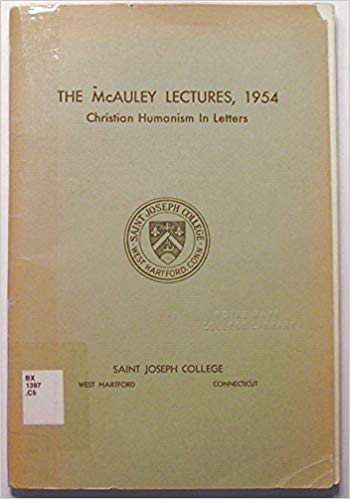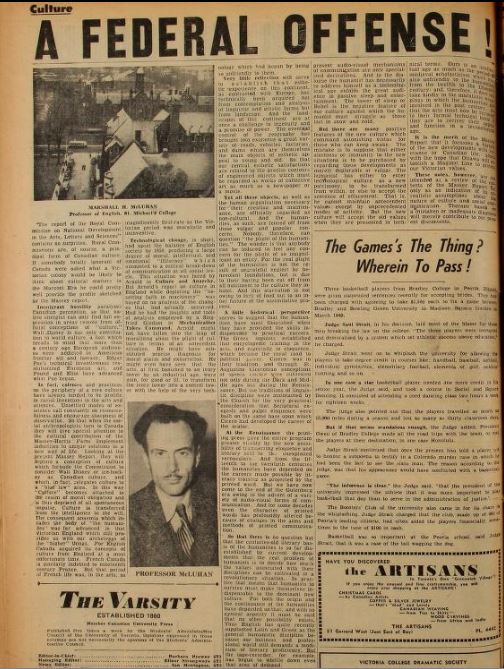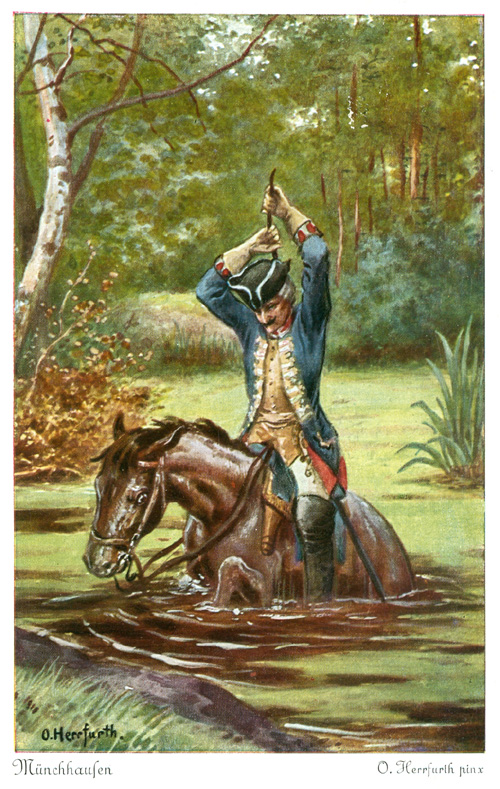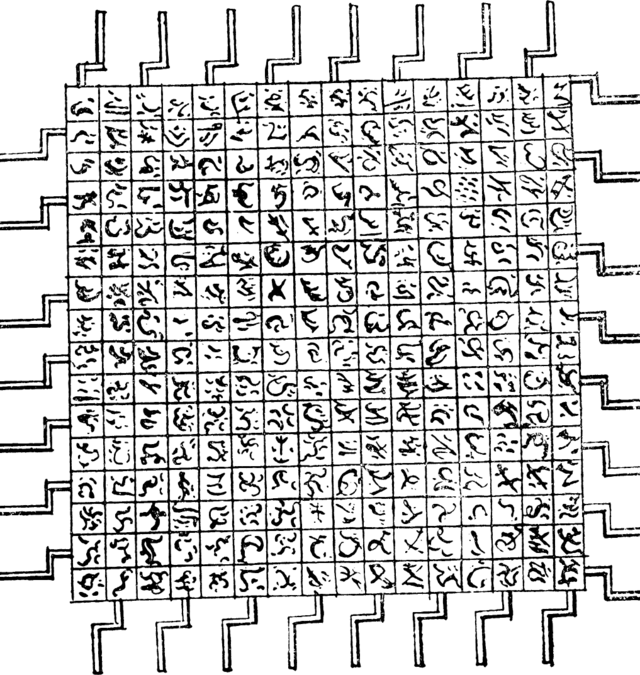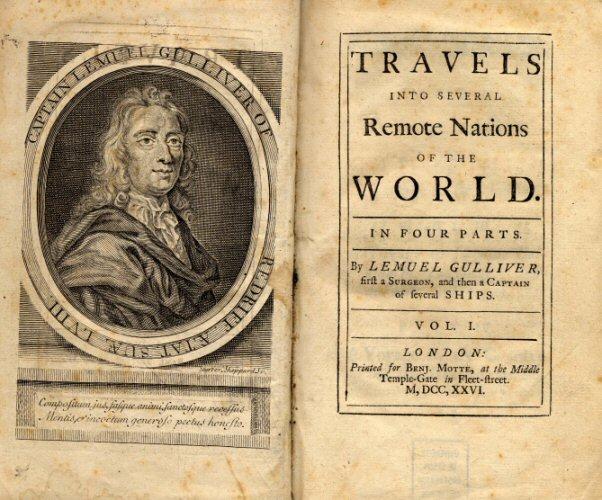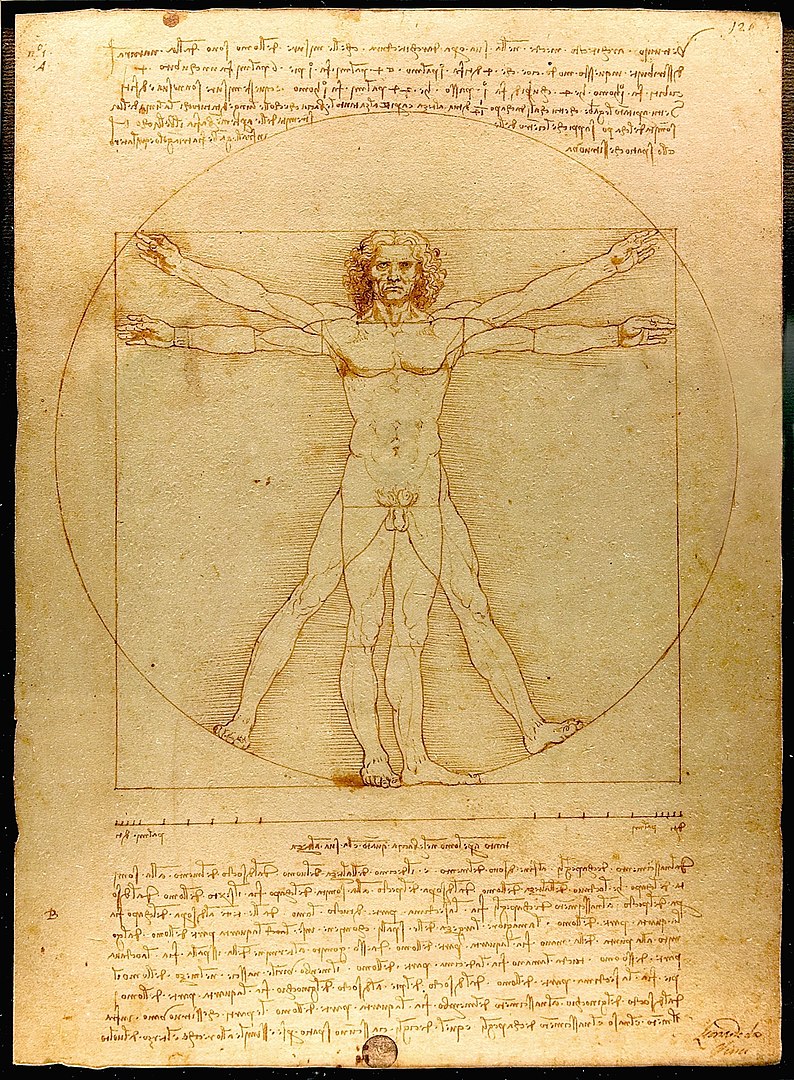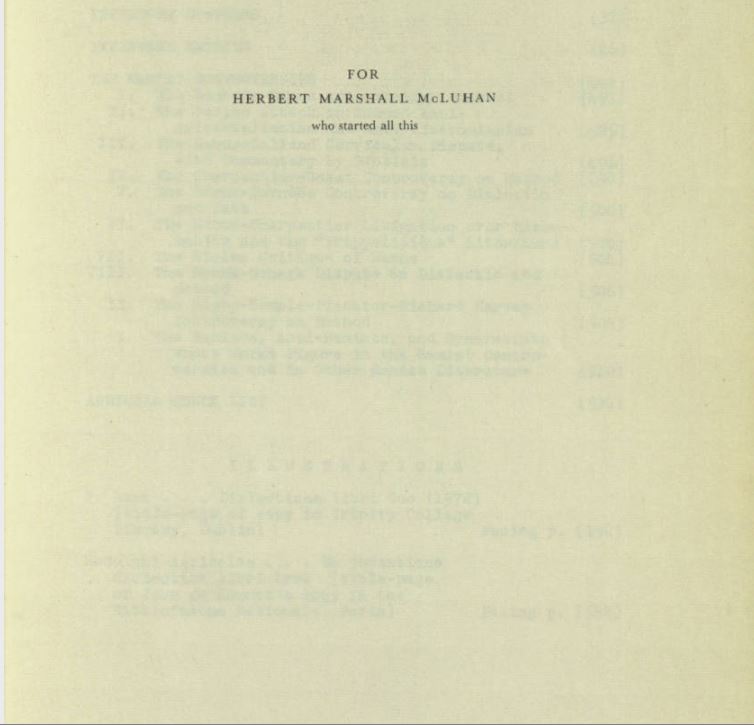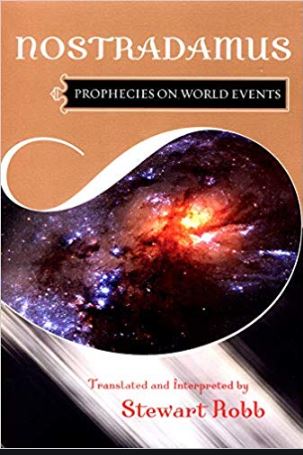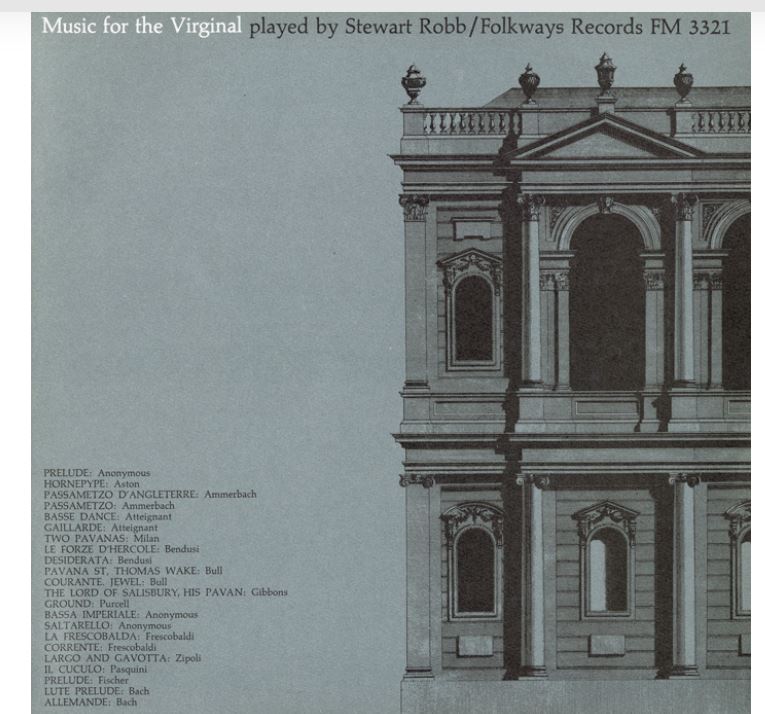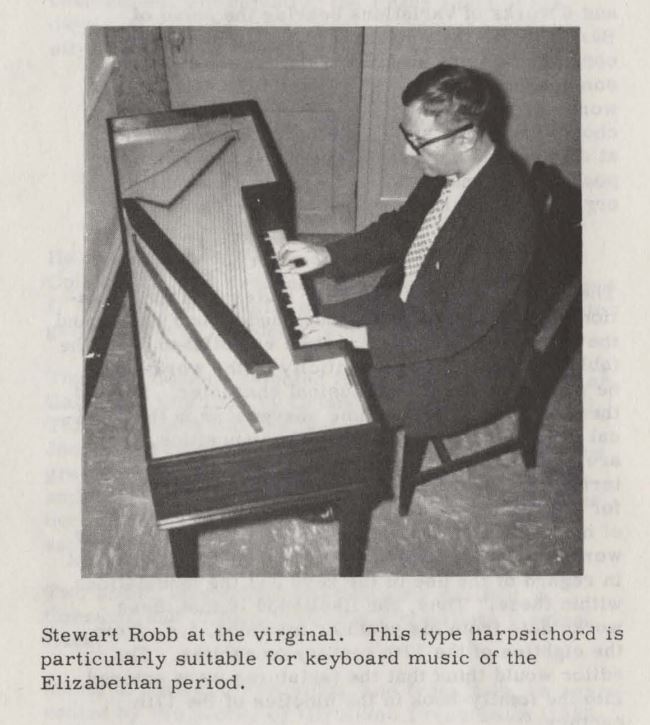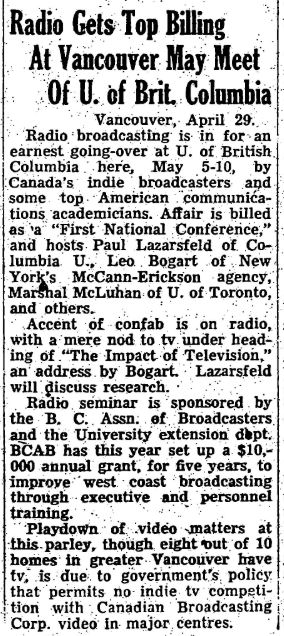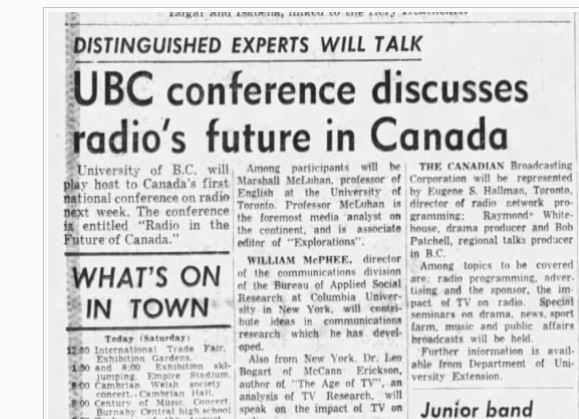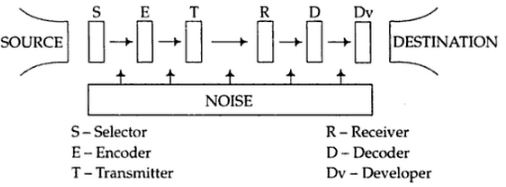McLuhan appears to have read Eisenstein’s 1949 Film Form in 1950, if not already in 1949. His ‘heavily annotated’ copy (mostly consisting of notes at the end of the book) remains in the Fisher Library McLuhan collection in Toronto. Eisenstein’s earlier Film Sense (1947) was read and cited by McLuhan as well, but it is not in the Fisher collection.
Beginning early in 1951, and continuing throughout the year, McLuhan mentioned Eisenstein in many different contexts:
Mechanical Bride1
it is easy to see that the basic techniques of both high and popular arts are now the same. Eisenstein is certainly of this opinion in his Film Sense, when he quotes René Guilleré2 on the close relation between jazz and cubism: ” (…) In jazz all elements are brought to the foreground. This is an important law which can be found in painting, in stage design, in films, and in the poetry of this period.” For the purposes of the present book it is also important to detect this “law” at work all around us because of the intelligibility it releases from such diverse situations. As the unity of the modern world becomes increasingly a technological rather than a social affair, the techniques of the arts provide the most valuable means of insight into the real direction of our own collective purposes. Conversely, the arts can become a primary means of social orientation and self-criticism.3
To Ezra Pound, January 5 19514
Eisenstein’s Film Form (Harcourt Brace 1949) [is] excellent on importance of Jap NOH [theatre] for cinema and of ideogram as basic grammar of montage.5 (…) My object is to learn the grammar and general language of major 20 fields in order to help on an orchestra among the arts. Cf. S. Giedion’s Mechanization Takes Command as a sample of how I should like to set up a school of literary studies. (…) You and Eisenstein have shown me how to make use of Chinese ideogram to elicit the natural modes of American sensibility. But I’ve just begun. Feeling my way.
McLuhan to Harold Innis, March 14, 19516
Mallarmé saw the modern press as a magical institution born of technology. The discontinuous juxtaposition of unrelated items made necessary by the influx of news stories from every quarter of the world, created, he saw, a symbolic landscape of great power and importance. (He used the word “symbol” in the strict Greek sense sym-ballein, to pitch together, physically and musically). He saw at once that the modern press was not a rational form but a magical one so far as communication was concerned. Its very technological form was bound to be efficacious far beyond any informative purpose.7 Politics were becoming musical, jazzy, magical.
The same symbolist perception applied to cinema showed that the montage of images was basically a return via technology to age-old picture language. S. Eisenstein’s Film Forum and Film [Sense]8 explore the relations between modern developments in the arts and Chinese ideogram, pointing to the common basis of ideogram in modern art, science and technology.
One major discovery of the symbolists which had the greatest importance for subsequent investigation was their notion of the learning process as a labyrinth of the senses and faculties whose retracing provided the key to all arts and sciences.
Joyce, Mallarmé and the Press9
just how valid were the impressionist techniques of the picturesque kind familiar to the news reporter appears in the notable essay of Eisenstein in Film Form where he shows the impact of Dickens on the art of DW Griffiths. How deeply English artists had understood the principles of picturesque art by 1780 appears from the invention of cinema at that time. In 1781 De Loutherbourg, the theatrical scene-painter, contrived in London a panorama which he called the “Eidophusikon” so as “to realize pictures in all four dimensions”. His “Various Imitations of Natural Phenomena, Represented by Moving Pictures” were advertised in these words and caused a sensation. Gainsborough, we are told by a contemporary, “was so delighted that for a time he thought of nothing else, talked of nothing else, and passed his evenings at the exhibition in long succession.” He even made one of these machines for himself capable of showing sunrise and moonrise as well as storms and ships at sea. Gainsborough through this cinema was experiencing the novelty of cubism with “lo spettatore nel centro del quadro“. (…) Once picturesque art, following the spectroscope, had broken up the continuum of linear art and narrative the possibility of cinematic montage emerged at once. And montage has to be arranged forwards or backwards. Forwards it yields narrative. Backwards it is reconstruction of events. Arrested it consists of the static landscape of the press, the co-existence of all aspects of community life. This is the image of the city presented in Ulysses.
To Ezra Pound, August 2, 195110
Landscape as a means of unifying inner and outer, strict observation plus erudition, leading to perfect control of states of mind — zoning device etc. Inclusive consciousness. Mosaic of precise juxtapositions in mutual irritation and tension generating power greatly in excess of mere sum of parts.
Eisenstein’s Film Form has the best treatment I know of this in relation to Chinese ideogram.
Cinema was immediate consequence of discovery of discontinuity as principle of picturesque landscape. MOVING PICTURES were made and shown in Naples and London in 1770. Painted scenes on rollers projected by lantern. This led at once to discovery of principle of reconstruction of situation by intellectual retracing. Retracing conditions leading to moment of aesthetic apprehension and arrest was Poe’s discovery. Led to detective story and symbolist poem. Detective story as reconstruction of crime by cinematic projection within the mind. Crime not explained but revealed.
- The Mechanical Bride was published in January 1951, but it was written in the 1940s, perhaps with some limited input in 1950. ↩
- Guilleré (1878-1931) is cited at great length (5 pages!) by Eisenstein in Film Sense from Guilleré’s posthumously published essay ‘Il n’y a plus de perspective’, Le Cahier bleu, no 4, 1933. Cf, Film Sense, 94-99. ↩
- MB, 87. Compare McLuhan to Innis in his March 14, 1951, letter: “Arts here used as providing criteria, techniques of observation, and bodies of recorded, achieved (archived?), experience. Points of departure but also return.” ↩
- Letters, 218. ↩
- Eisenstein’s ‘The Cinematic Principle and the Ideogram’ (in Film Form): “Cinematography is, first and foremost, montage. (…) the “copulation” (perhaps we had better say, the combination) of two hieroglyphs of the simplest series is to be regarded not as their sum, but as their product, ie, as a value of another dimension, another degree; each separately, corresponds to an object, to a fact, but their combination corresponds to a concept. From separate hieroglyphs has been fused — the ideogram. By the combination of two “depictables” is achieved the representation of something that is graphically undepictable. For example: the picture of water and the picture of an eye signifies to weep; the picture of an ear near the drawing of a door = “to listen” (…) But this is montage! Yes. It is exactly what we do in the cinema, combining shots that are depictive, single in meaning, neutral in content, into intellectual contents and series.” Compare the principles of Chinese writing set out by Ernest Fenollosa in his essay, edited by Pound, on The Chinese Written Character: “So far we have exhibited the Chinese characters and the Chinese sentence chiefly as vivid shorthand pictures of actions and processes in nature. These embody the poetry as far as they go. Such actions are seen, but Chinese would be a poor language and Chinese poetry but a narrow art, could they not go on to represent also what is unseen. The best poetry deals not only with natural images but with lofty thoughts, spiritual suggestions, and obscure relations (…) You will ask, how could the Chinese have built up a great intellectual fabric from mere picture writing? To the ordinary western mind (…) this feat seems quite impossible. Yet the Chinese language with its peculiar materials has passed over from the seen to the unseen by exactly the same process which all ancient races employed. The process is metaphor, the use of material images to suggest immaterial relations.” ↩
- Letters 221. McLuhan’s letter to Innis of March 14, 1951, was a rewrite of an earlier letter that Innis answered in February with apologies for his delay in doing so. It is not known when that earlier letter was written, but it must have been early in 1951 or even late in 1950. ↩
- “Its very technological form was bound to be efficacious far beyond any informative purpose.” This is “the medium is the message” already in 1951. ↩
- Instead of ‘Film Sense‘, McLuhan has ‘Film Technique‘ here, which was a volume on film theory not by Eisenstein, but by his fellow film director and friend, Vsevolod Pudovkin. ↩
- ‘Joyce, Mallarmé and the Press’, Sewanee Review, 62(1), 38-55, 1954. This paper was written and submitted to Sewanee in 1951 but took three years to appear. McLuhan apparently made some minor modifications to it just before it was finally published. ↩
- Letters, 224. ↩
